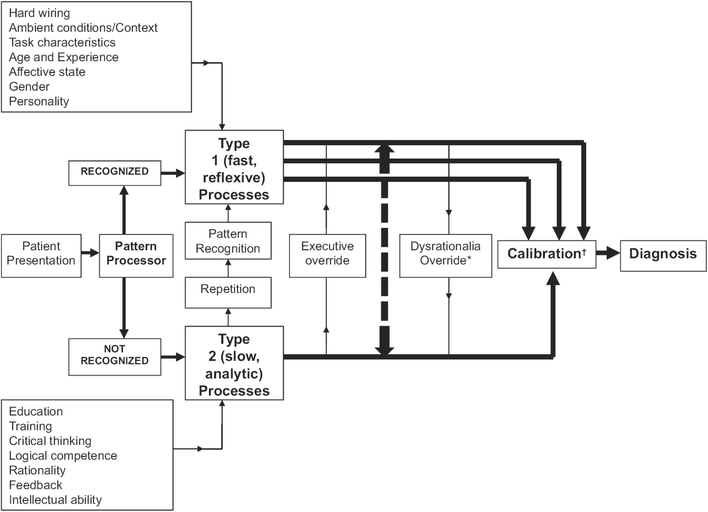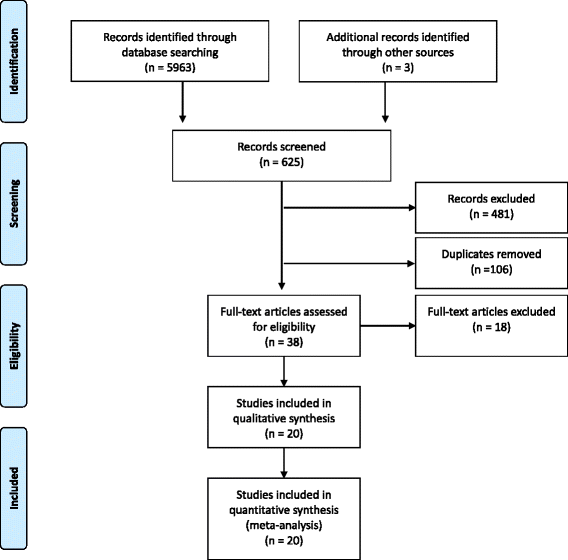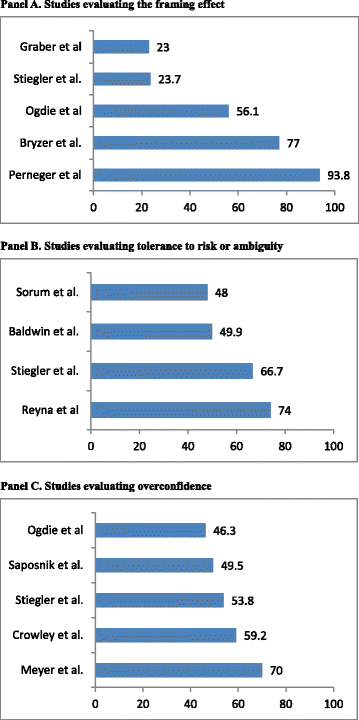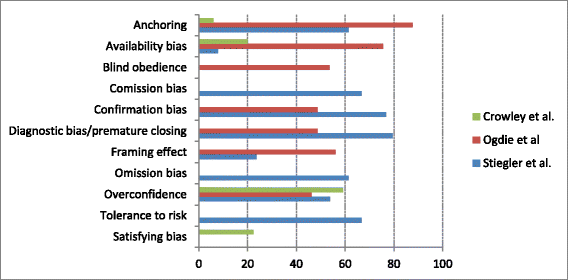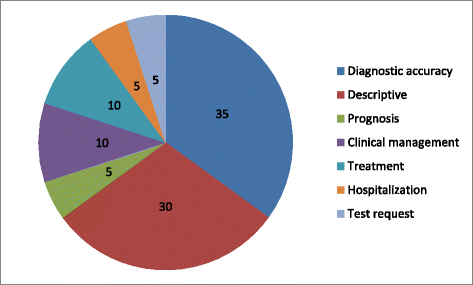Cognitive biases associated with medical decisions: a systematic review - PubMed (original) (raw)
Cognitive biases associated with medical decisions: a systematic review
Gustavo Saposnik et al. BMC Med Inform Decis Mak. 2016.
Abstract
Background: Cognitive biases and personality traits (aversion to risk or ambiguity) may lead to diagnostic inaccuracies and medical errors resulting in mismanagement or inadequate utilization of resources. We conducted a systematic review with four objectives: 1) to identify the most common cognitive biases, 2) to evaluate the influence of cognitive biases on diagnostic accuracy or management errors, 3) to determine their impact on patient outcomes, and 4) to identify literature gaps.
Methods: We searched MEDLINE and the Cochrane Library databases for relevant articles on cognitive biases from 1980 to May 2015. We included studies conducted in physicians that evaluated at least one cognitive factor using case-vignettes or real scenarios and reported an associated outcome written in English. Data quality was assessed by the Newcastle-Ottawa scale. Among 114 publications, 20 studies comprising 6810 physicians met the inclusion criteria. Nineteen cognitive biases were identified.
Results: All studies found at least one cognitive bias or personality trait to affect physicians. Overconfidence, lower tolerance to risk, the anchoring effect, and information and availability biases were associated with diagnostic inaccuracies in 36.5 to 77 % of case-scenarios. Five out of seven (71.4 %) studies showed an association between cognitive biases and therapeutic or management errors. Of two (10 %) studies evaluating the impact of cognitive biases or personality traits on patient outcomes, only one showed that higher tolerance to ambiguity was associated with increased medical complications (9.7 % vs 6.5 %; p = .004). Most studies (60 %) targeted cognitive biases in diagnostic tasks, fewer focused on treatment or management (35 %) and on prognosis (10 %). Literature gaps include potentially relevant biases (e.g. aggregate bias, feedback sanction, hindsight bias) not investigated in the included studies. Moreover, only five (25 %) studies used clinical guidelines as the framework to determine diagnostic or treatment errors. Most studies (n = 12, 60 %) were classified as low quality.
Conclusions: Overconfidence, the anchoring effect, information and availability bias, and tolerance to risk may be associated with diagnostic inaccuracies or suboptimal management. More comprehensive studies are needed to determine the prevalence of cognitive biases and personality traits and their potential impact on physicians' decisions, medical errors, and patient outcomes.
Keywords: Case-scenarios; Cognition; Cognitive bias; Decision making; Personality traits; Physicians; Systematic review.
Figures
Fig. 1
A model for diagnostic reasoning based on dual-process theory (from Ely et al. with permission).[9] System 1 thinking can be influenced by multiple factors, many of them subconscious (emotional polarization toward the patient, recent experience with the diagnosis being considered, specific cognitive or affective biases), and is therefore represented with multiple channels, whereas system 2 processes are, in a given instance, single-channeled and linear. System 2 overrides system 1 (executive override) when physicians take a time-out to reflect on their thinking, possibly with the help of checklists. In contrast, system 1 may irrationally override system 2 when physicians insist on going their own way (e.g., ignoring evidence-based clinical decision rules that can usually outperform them). Notes: Dysrationalia denotes the inability to think rationally despite adequate intelligence. “Calibration” denotes the degree to which the perceived and actual diagnostic accuracy correspond
Fig. 2
PRISMA flow diagram
Fig. 3
Prevalence of most common cognitive biases as reported by different studies. Numbers represent percentages reflecting the frequency of the cognitive factor/bias. Panel a represent the prevalence of the framing effect. Panel b represent the prevalence of prevalence of tolerance to risk and ambiguity. Panel c represents the prevalence of overconfidence. Overall, overconfidence and low tolerance to risk or ambiguity were found in 50-70 % of participants, whereas a wide variation was found for the framing effect
Fig. 4
Prevalence of cognitive biases in the top three most comprehensive studies [39, 50, 52] Numbers represent percentages reflecting the frequency of the cognitive bias. Note the wide variation in the prevalence of cognitive biases across studies
Fig. 5
Outcome measures of studies evaluating cognitive biases. Numbers represent percentages. Total number of studies = 20. Note that 30 % of studies are descriptive and 35 % target diagnostic accuracy. Only few studies evaluated medical management, treatment, hospitalization or prognosis
Similar articles
- Drugs for preventing postoperative nausea and vomiting in adults after general anaesthesia: a network meta-analysis.
Weibel S, Rücker G, Eberhart LH, Pace NL, Hartl HM, Jordan OL, Mayer D, Riemer M, Schaefer MS, Raj D, Backhaus I, Helf A, Schlesinger T, Kienbaum P, Kranke P. Weibel S, et al. Cochrane Database Syst Rev. 2020 Oct 19;10(10):CD012859. doi: 10.1002/14651858.CD012859.pub2. Cochrane Database Syst Rev. 2020. PMID: 33075160 Free PMC article. - Clinical judgement by primary care physicians for the diagnosis of all-cause dementia or cognitive impairment in symptomatic people.
Creavin ST, Noel-Storr AH, Langdon RJ, Richard E, Creavin AL, Cullum S, Purdy S, Ben-Shlomo Y. Creavin ST, et al. Cochrane Database Syst Rev. 2022 Jun 16;6(6):CD012558. doi: 10.1002/14651858.CD012558.pub2. Cochrane Database Syst Rev. 2022. PMID: 35709018 Free PMC article. - Interventions to improve inhaler technique for people with asthma.
Normansell R, Kew KM, Mathioudakis AG. Normansell R, et al. Cochrane Database Syst Rev. 2017 Mar 13;3(3):CD012286. doi: 10.1002/14651858.CD012286.pub2. Cochrane Database Syst Rev. 2017. PMID: 28288272 Free PMC article. - Education support services for improving school engagement and academic performance of children and adolescents with a chronic health condition.
Barnett T, Tollit M, Ratnapalan S, Sawyer SM, Kelaher M. Barnett T, et al. Cochrane Database Syst Rev. 2023 Feb 8;2(2):CD011538. doi: 10.1002/14651858.CD011538.pub2. Cochrane Database Syst Rev. 2023. PMID: 36752365 Free PMC article. - Systemic treatments for metastatic cutaneous melanoma.
Pasquali S, Hadjinicolaou AV, Chiarion Sileni V, Rossi CR, Mocellin S. Pasquali S, et al. Cochrane Database Syst Rev. 2018 Feb 6;2(2):CD011123. doi: 10.1002/14651858.CD011123.pub2. Cochrane Database Syst Rev. 2018. PMID: 29405038 Free PMC article.
Cited by
- Exploring Predictors of Moral Disengagement in Collegiate Athletic Trainers.
Budziszewski R, Graupensperger SA, Vierimaa M. Budziszewski R, et al. J Athl Train. 2020 Jan;55(1):96-104. doi: 10.4085/1062-6050-504-18. Epub 2019 Nov 12. J Athl Train. 2020. PMID: 31714851 Free PMC article. - Understanding the Influence of Patient Factors on Accuracy and Decision-Making in a Diagnostic Accuracy Study with Multiple Raters-A Case Study from Dentistry.
Vach K, Schlueter N, Ganss C, Vach W. Vach K, et al. Int J Environ Res Public Health. 2023 Jan 18;20(3):1781. doi: 10.3390/ijerph20031781. Int J Environ Res Public Health. 2023. PMID: 36767148 Free PMC article. - What factors could influence physicians' management of women of childbearing age with chronic inflammatory disease? A systematic review of behavioural determinants of clinical inertia.
Nelson-Piercy C, Vlaev I, Harris K, Fischer-Betz R. Nelson-Piercy C, et al. BMC Health Serv Res. 2019 Nov 21;19(1):863. doi: 10.1186/s12913-019-4693-x. BMC Health Serv Res. 2019. PMID: 31752837 Free PMC article. - A concept for adapting medical education to the next generations via three-staged digital peer teaching key feature cases.
Supper P, Urban D, Acker I, Linke FS, Kienast P, Praschinger A, Anvari-Pirsch A. Supper P, et al. Wien Med Wochenschr. 2023 Apr;173(5-6):108-114. doi: 10.1007/s10354-022-00990-7. Epub 2022 Dec 21. Wien Med Wochenschr. 2023. PMID: 36542219 Free PMC article. - Allergic reaction to anisakis-contaminated fish after the first administration of BNT162b2 mRNA vaccine: a case report.
Harada F, Yamamoto K, Matsuda T, Yamamoto C, Tani Y, Ohnishi M, Takita M, Tanimoto T, Kami M, Shineha R. Harada F, et al. Gastroenterol Rep (Oxf). 2022 Aug 11;10:goac034. doi: 10.1093/gastro/goac034. eCollection 2022. Gastroenterol Rep (Oxf). 2022. PMID: 35966631 Free PMC article. No abstract available.
References
- Bates DW, Cullen DJ, Laird N, Petersen LA, Small SD, Servi D, Laffel G, Sweitzer BJ, Shea BF, Hallisey R, et al. Incidence of adverse drug events and potential adverse drug events. Implications for prevention. ADE Prevention Study Group. JAMA. 1995;274(1):29–34. doi: 10.1001/jama.1995.03530010043033. - DOI - PubMed
- Andel C, Davidow SL, Hollander M, Moreno DA. The economics of health care quality and medical errors. J Health Care Finance. 2012;39(1):39–50. - PubMed
- OECD. Health at a Glance 2013: OECD Indicators, OECD Publishing. 2013.http://dx.doi.org/10.1787/health_glance-2013-en. - DOI
Publication types
MeSH terms
LinkOut - more resources
Full Text Sources
Other Literature Sources
Miscellaneous
